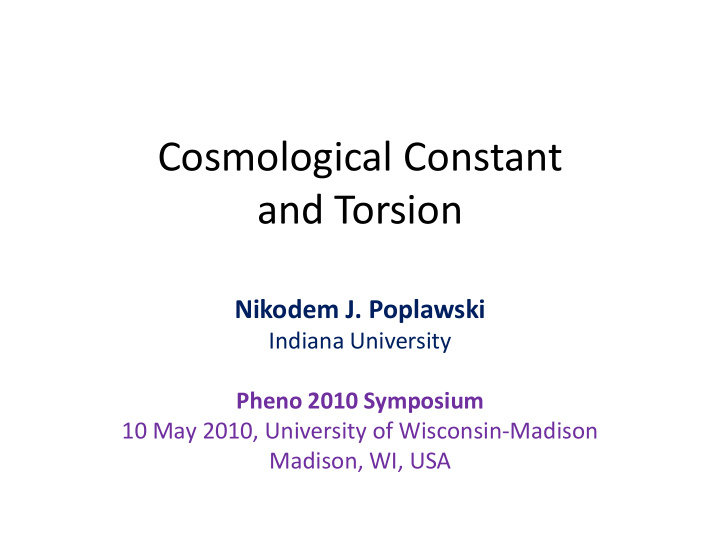



Cosmological Constant and Torsion Nikodem J. Poplawski Indiana University Pheno 2010 Symposium 10 May 2010, University of Wisconsin-Madison Madison, WI, USA
Simplest explanation of current cosmic acceleration (dark energy) – positive Cosmological Constant (or vacuum energy density) Measured value: Quantum field theory – zero-point energy of vacuum: 120 orders of magnitude larger than observed – very bad Zel’dovich: cosmological constant from particle physics (dimensional arguments) Arguments for Λ = 0 – before cosmic acceleration discovered (Hawking; Linde; Coleman) Huge cosmological constant from zero-point energy of vacuum may be reduced via dynamical processes (Abbott; Brown & Teitelboim; Steinhardt & Turok; Klinkhamer & Volovik) Or: Λ can be simply another constant of Nature
Cosmological constant from particle physics (examples) • QCD trace anomaly from gluon and quark condensates (Schutzhold) • QCD gluon condensate (Klinkhamer & Volovik) resembles Zel’dovich formula • QCD chiral quark condensate (Urban & Zhitnitsky) • Electroweak phase transition (Klinkhamer & Volovik) • BCS condensate of fermions and torsion (Alexander, Biswas & Calcagni)
Einstein-Cartan gravity • Naturally extends GR to include matter with spin • Spin produces torsion (antisymmetric part of affine connection); torsion proportional to spin density • EC gravity provides more complete account of local gauge invariance with respect to Poincare group • Viable theory of gravity; differs significantly from GR only at densities much larger than nuclear matter density • May prevent formation of singularities from fermionic matter (which builds all stars) NJ Poplawski, Phys. Lett. B, in press (2010) • Requires fermions to be extended, introducing effective ultraviolet cutoff in QFT
Dirac Lagrangian and torsion → Heisenberg-Ivanenko equation (semicolon – GR covariant derivative) Effective metric Lagrangian for H-I equation Energy-momentum tensor for H-I Lagrangian
H-I energy-momentum tensor GR part cosmological term Effective cosmological constant NJ Poplawski arXiv:1005.0893 Vacuum energy density Not constant in time, but constant in space at cosmological distances for homogeneous and isotropic Universe
Cosmological constant if spinor field forms condensate with nonzero vacuum expectation value, e.g., in QCD Vacuum-state-dominance approximation (Shifman, Vainshtein and Zakharov) For quark fields Axial vector-axial vector form of H-I four-fermion interaction gives positive cosmological constant
Cosmological constant from QCD vacuum and EC torsion reproduces Zel’dovich formula This value would agree with observations if • Energy scale of torsion-induced cosmological constant from QCD vacuum only ~ 8 times larger than observed • Contribution from spinor fields with lower VEV, e.g. neutrino condensates could decrease average such that torsion- induced cosmological constant would agree with observations • Simplest model predicting positive cosmological constant and ~ its energy scale; does not use new fields
Recommend
More recommend